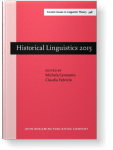Chapter 13
State representation and dynamic processes in Homeric Greek
The aorist in - in Homeric Greek
We aim to assess the relationship between different Indo-European strategies for encoding the representation of a subject’s state and focus on data from Homeric poems. Specifically, we propose an explanation for the function and the distribution of the aorist in –ην that (1) accounts for its various occurrences within a unitary model, (2) sheds new light on the co-existence of stative and dynamic components in this formation, (3) allows us to solve the supposed aporia whereby a stative marker has been integrated into the aorist system. Moreover, we investigate the relationship between the aorist in –ην and two major categories that entail a state predicate, that is, the old perfect and the middle voice, in order to clarify their distinctive functions and mutual distribution.
Article outline
- 1.State representation and intransitive values of the aorist in –ην: Open questions
- 2.Function and distribution of the aorist in –ην and its relationship with middle and perfect
- 2.1The anticausative function of the aorist in –ην
- 2.2Aorist in –ην and media tantum verbs
- 2.3Aorist in –ην, middle and perfect
- 3.Conclusions
-
Notes
-
References
-
Translations
